Reserve Bank of Australia Annual Report – 1998 Customer Services
The Reserve Bank provides a range of services to customers – banking services for governments, registry services for the Commonwealth and some State government and overseas agencies, electronic settlement facilities for CGS and other transactions using the Reserve Bank Information and Transfer System (RITS), and a bulk currency note-issue facility. All of these activities have recently been reviewed to ensure their operations are efficient and conform to the principles of competitive neutrality. A part of the note-issue function, the specialised currency-distribution service to individual bank branches in metropolitan areas, which had been in operation for more than 30 years, was terminated in mid July 1998. As noted earlier in this Report, the real-time gross settlement (RTGS) system became fully operational on 22 June 1998; the newly formed Payments Settlements Department manages and operates this system.
The expansion of electronic processing of banking and securities transactions, the reorganisation of cash processing and distribution, and the centralisation of functions to improve efficiency have had a substantial impact on the Reserve Bank's branches. Because the amount of remaining business conducted in the Northern Territory had shrunk to a very low level, it was no longer viable to maintain even a very small branch and the Bank closed its Darwin branch on 31 October 1997. Later, as a result of the loss of the Tasmanian Government banking business and the reorganisation of the cash-distribution operations, it was decided to close the Bank's Hobart branch in the second half of 1998 for the same reason.
Some of the services provided by the Reserve Bank to customers are contestable, i.e. they can also be provided by private-sector organisations. Other services, such as RTGS and note issue, are core, non-contestable central banking functions. Provision of contestable services by the Reserve Bank is organised on a business-unit basis to facilitate transparency and accountability; each business unit aims for full cost recovery and an appropriate return on capital.
In 1997/98, revenues from contestable activities were $43.1 million, compared with costs of $36.8 million. The latter include direct and indirect costs, commercially based rents and fully allocated overheads in line with competitive neutrality principles.
Banking
During the year, the Reserve Bank continued to seek improvements in its banking operations in order to upgrade the quality of services provided to customers and to improve the profitability of the business.
During 1997/98, outsourcing of cheque-processing operations was commenced, with the Commonwealth Bank of Australia (CBA) being selected as the external service provider. The need to re-equip all branches with new cheque-processing equipment, combined with the likelihood of a further contraction in the volume of its cheque processing, led the Reserve Bank to outsource these operations in order to exploit the economies of scale offered by external providers. The first stage of the project has been implemented and, under agreed arrangements, cheques drawn on the Reserve Bank are now processed by the CBA, which electronically transmits cheque data to the Bank. Outsourcing of the remaining portion of the Reserve Bank's cheque-processing operations (cheques drawn on other financial institutions deposited by Reserve Bank customers) is expected to be completed late in 1998.
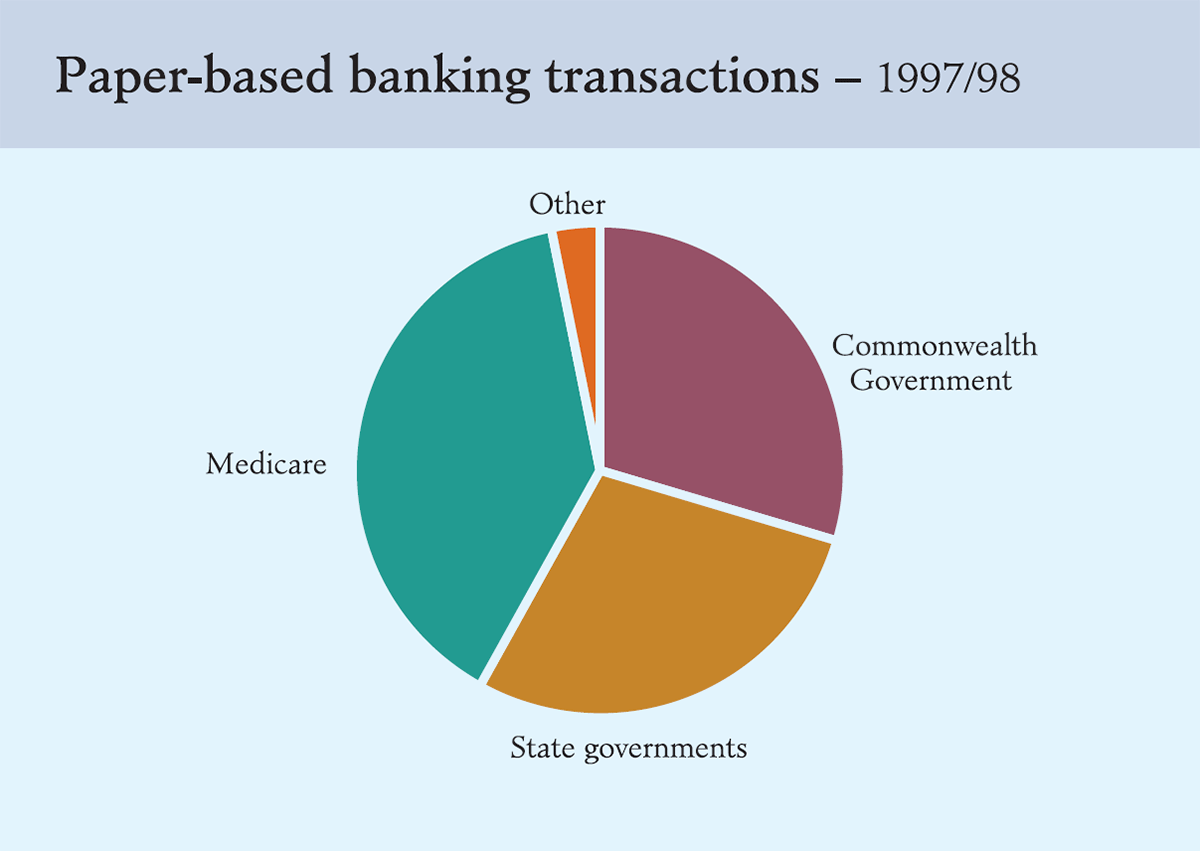
Another innovation was the development of a counter terminal system that provides customers receiving payments from the public with the ability to capture all receipts data needed for updating their systems, as well as all cheque and payment details required for banking purposes to enable same-day crediting to accounts. The system initially operated as a pilot with the Australian Taxation Office (ATO) and it was successfully implemented in the first ATO site in October 1997.
In conformity with competitive neutrality principles, it was agreed in discussions with the Commonwealth Treasury and Department of Finance and Administration (DoFA) that the core account-keeping function, involving the conduct of the Commonwealth Public Account (CPA) and associated major accounts, is a non-contestable area of the banking business. The major cash flows to and from the Government pass through these accounts. It is important for the implementation of monetary policy and for the smooth operation of RTGS that this account-keeping function, which involves handling the Commonwealth's cash balances, remains with the Reserve Bank. To make this clear in operational terms, it is intended in 1998/99 to restructure the banking business to separate the core account-keeping functions associated with the CPA from the transactions-processing part of the banking business, which is one of the contestable services provided.
The Reserve Bank also has been working closely with the Accrual Budgeting Project Group established by DoFA to oversee and co-ordinate the implementation of an accrual budgeting framework within the Commonwealth, and to devolve responsibility for banking arrangements to individual budget-sector agencies to replace the present largely centralised administration of banking arrangements. Involvement with the Accrual Budgeting Project Group has centred on providing advice on appropriate bank-account structures and information flows to meet agencies' management-information requirements; developing mechanisms to encourage best cash-management practices; and ensuring that management of cash balances and cash-flow forecasting facilitate the Commonwealth's debt management objectives and the Bank's liquidity management responsibilities.
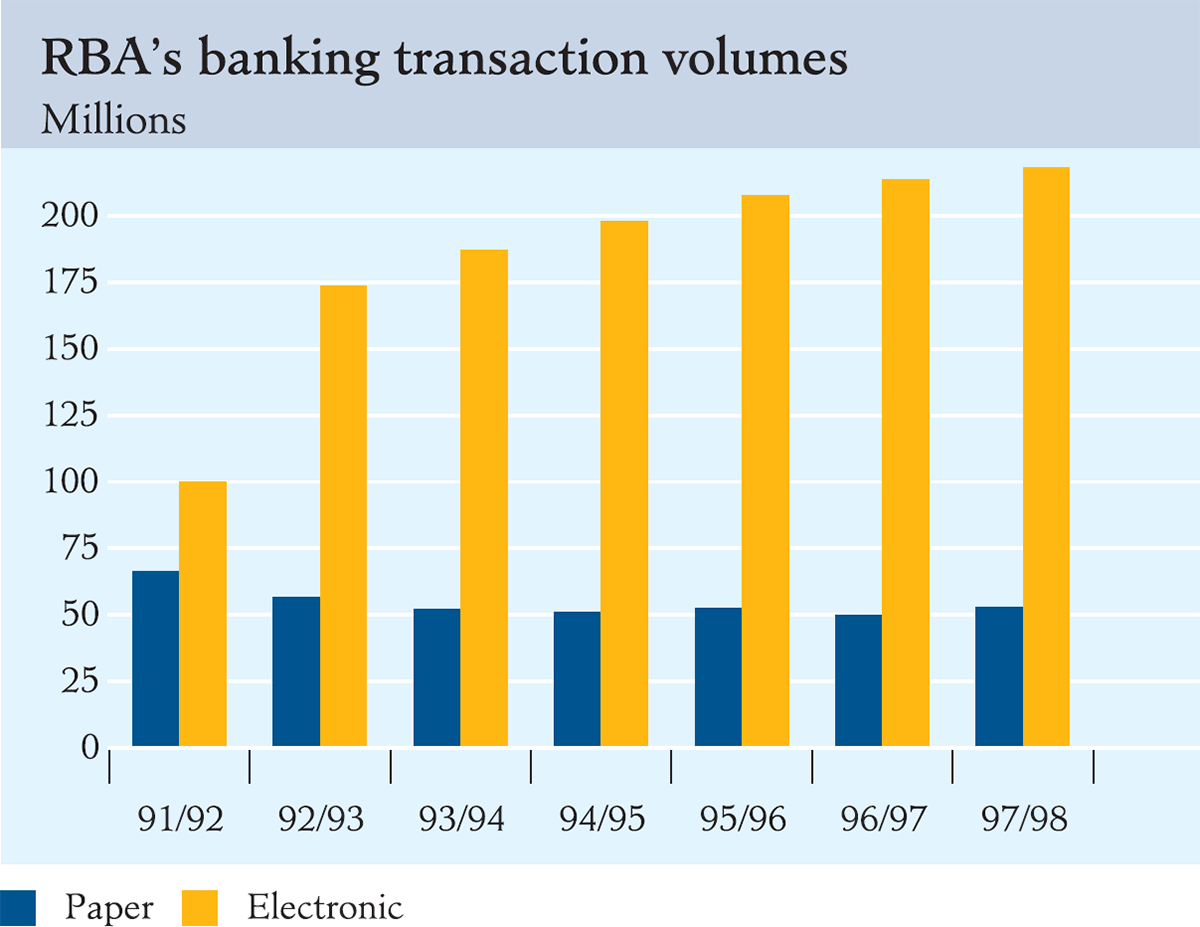
Banking business volumes increased further in 1997/98. Electronic transactions processed through the Reserve Bank's Government Direct Entry System (GDES) increased by around 2 per cent to 218 million. GDES receives payments data from various customers and subsequently electronically distributes the payments to a wide range of financial institutions. Reflecting the continuing devolution of banking responsibilities to individual State government agencies, the number of customers using ReserveLink, the Bank's PC-based banking package, continued to grow during 1997/98, rising from 278 at end June 1997 to 338 a year later.
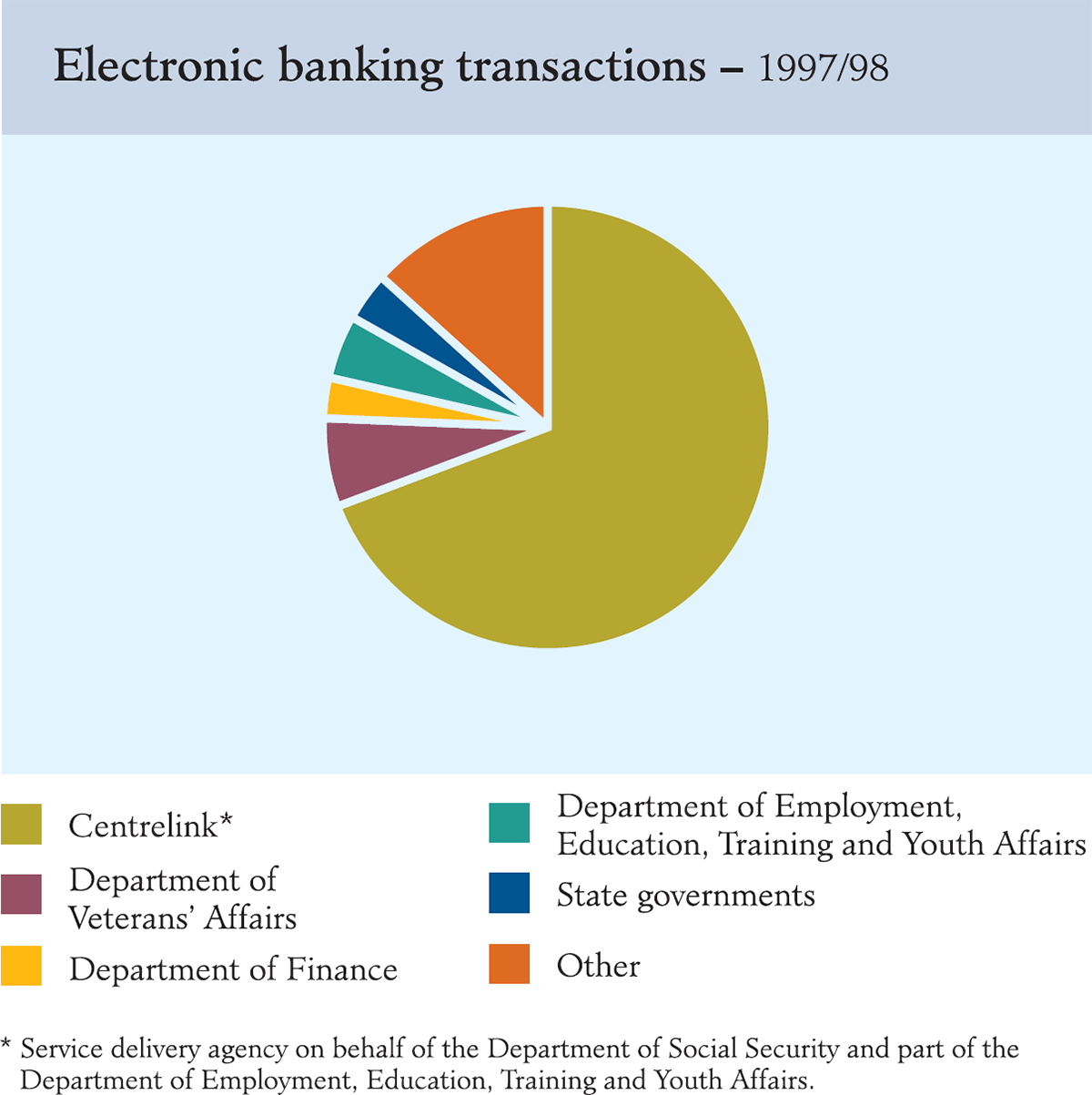
Net earnings from the government banking business rose from $2.8 million in 1996/97 to $3.4 million in 1997/98. This increase reflected cost reductions achieved from restructuring the business as well as higher fee income.
| Total revenues | 35.5 |
|---|---|
| Total costs | 32.1 |
| Net earnings | 3.4 |
Registry and Settlement Services
Through its branch network, the Reserve Bank provides registry services on behalf of the Commonwealth Government, the State government borrowing authorities of South Australia and Western Australia, and other domestic and foreign official organisations. These services include the issue, transfer and registration of securities, maintenance of ownership records, periodical payment of interest and the redemption of securities at maturity.
During 1997/98, activity levels continued to decline. The volume of processing undertaken by debt registries generally is in decline as a result of the growth in electronic settlement and contraction in the number of issuers, which increasingly have access to cheaper and more flexible funding in wholesale markets. In response to the contracting business environment and as part of the Reserve Bank's continued efforts to improve operational efficiencies and reduce costs, staffing needs were reviewed and this part of the business was restructured during the year. In achieving these efficiencies, however, the Bank was mindful of the need to retain its focus on quality of service.
| Total revenues | 3.2 |
|---|---|
| Total costs | 2.4 |
| Net earnings | 0.8 |
Settlement services are based on RITS. This system, which allows members to settle their transactions in CGS electronically, handles about 95 per cent of turnover in the market and has $88 billion of securities lodged in it.
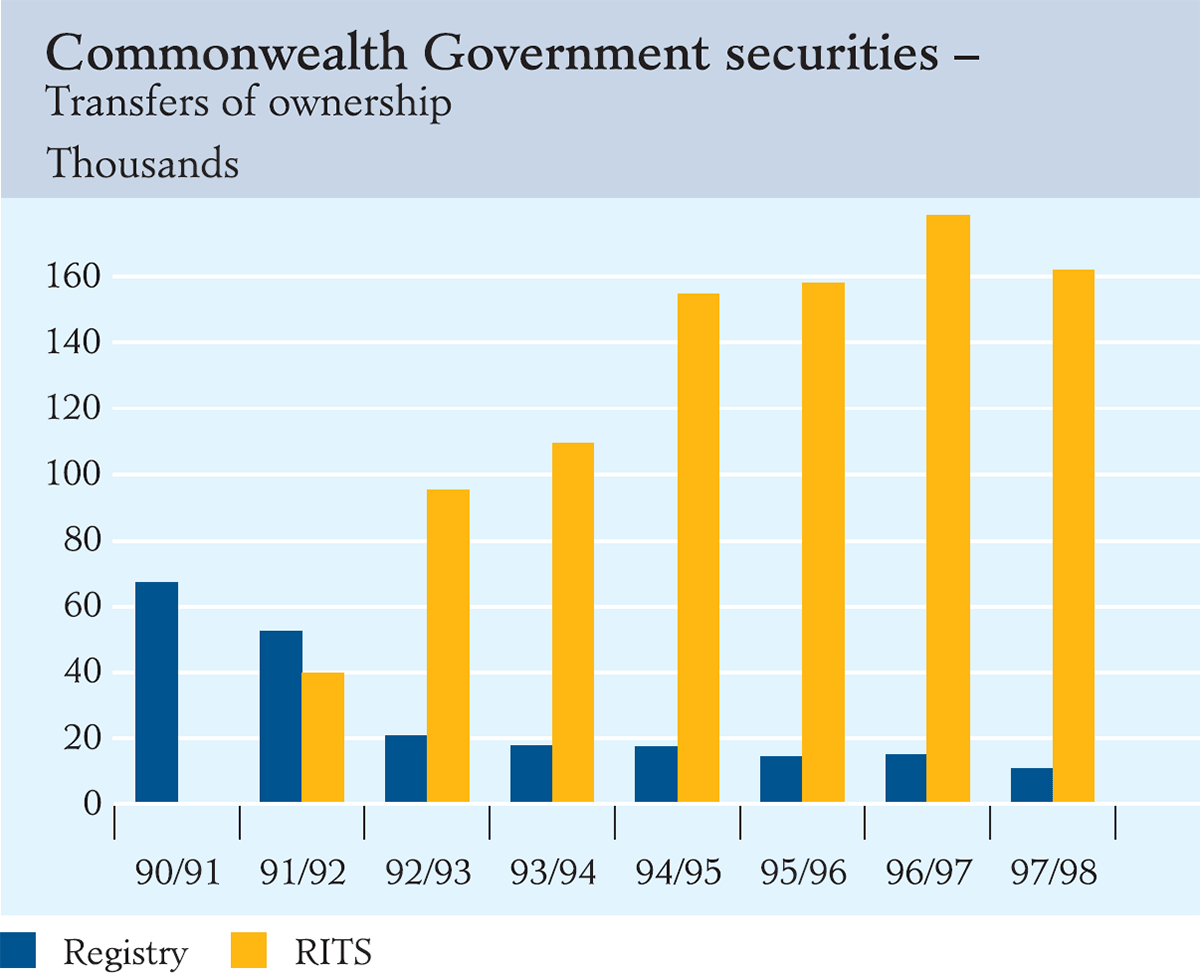
As well as the basic trade-settlement function, RITS also provides its 239 members with other facilities, including electronic tendering for CGS; the automatic payment of interest and maturity proceeds for securities held in the system; provision for members to use securities in RITS to secure loans and settle transactions; a capacity to make high-value payments; and a facility for simultaneous settlement of interbank obligations arising from the settlement of equity transactions on CHESS, the Australian Stock Exchange's electronic settlement facility.
As well as the services it provides for other participants in financial markets, the Reserve Bank also has settlement responsibilities arising from its own activities in the domestic securities and foreign exchange markets, and from the activities of its official customers domestically and abroad. These high-value transactions take place across SWIFT, RITS and Austraclear. The Bank also acts as collator of banks' obligations arising from the various settlement streams, advising them each morning of their net settlement positions. The consolidation of all settlement responsibilities in the Payments Settlements Department will lead to improved settlement efficiency and security by ensuring greater separation between the dealing areas of the Bank, where transactions are initiated, and the back-office settlement functions.
| Total revenues | 4.4 |
|---|---|
| Total costs | 2.3 |
| Net earnings | 2.1 |
Note Issue
The Bank's note-issue activities embrace the storage and issue of new and reissuable notes; the processing of notes returned from circulation for quality-control purposes; and research into and development of note designs and security features.
Extended experience with polymer currency notes continues to confirm the superiority of polymer notes over the paper notes they replaced. It is now over two years since the final note in the new series of polymer notes was issued. For practical purposes, all Australian currency notes in active circulation are now polymer. The benefits of polymer arise from greater security and durability, and reduced machine maintenance and processing requirements.

Note processing and distribution
Despite the strong growth in electronic payments media, such as EFTPOS and direct entry, the public's demand for currency notes has grown broadly in line with the economy over recent years. During 1997/98, the value of notes issued by the Reserve Bank rose by 7.9 per cent, which was well up from the previous few years. Use of $50 and $100 notes grew strongly; these two denominations now account for about 87 per cent of the value of notes on issue. During the year, the Reserve Bank issued into circulation around $69 billion in currency notes and had $68 billion in notes returned for processing. Of the total notes processed, about 93 per cent were classified as fit for reissue, a percentage which has increased because of the durability and cleanliness of polymer notes. Around 1.4 billion used notes were processed through the Bank's high-speed note-processing machines.
| At end June | $1 | $2 | $5 | $10 | $20 | $50 | $100 | Total | Increase (per cent) |
|---|---|---|---|---|---|---|---|---|---|
| 1993 | 42 | 70 | 297 | 591 | 1,813 | 6,284 | 7,269 | 16,367 | 7.8 |
| 1994 | 21 | 69 | 313 | 634 | 1,795 | 6,837 | 7,907 | 17,577 | 7.4 |
| 1995 | 20 | 49 | 332 | 614 | 1,848 | 7,193 | 8,482 | 18,538 | 5.5 |
| 1996 | 19 | 48 | 337 | 583 | 1,868 | 7,928 | 8,399 | 19,182 | 3.5 |
| 1997 | 19 | 47 | 351 | 601 | 1,837 | 8,912 | 8,297 | 20,064 | 4.6 |
| 1998 | 19 | 47 | 361 | 617 | 1,804 | 9,523 | 9,280 | 21,651 | 7.9 |
During the year, currency-note distribution and processing operations were reviewed and reorganised, and a number of significant productivity gains were achieved:
- The greater security and durability of polymer notes mean that they do not need to be checked as often for authenticity and wear and tear. In future, the Reserve Bank aims to achieve its objectives by processing notes in circulation on average twice each year, resulting in significant cost savings.
- The operational procedures in the cash services areas were streamlined, not only in relation to machine processing of notes, but also in the manner in which notes are returned to the Reserve Bank from the community and in handling and custodial arrangements within cash services areas.
- In mid July 1998, the Reserve Bank ceased the specialised currency-distribution service provided to some banks. Under this arrangement, currency notes were packed into bags which were distributed by armoured-car companies to individual bank branches in metropolitan areas. Surplus notes were returned to the Reserve Bank in a similar way. However, the Bank did not have a competitive advantage in this area and maintenance of the service had inhibited reform in the industry. The termination of this longstanding arrangement has provided the opportunity for all participants in the cash-handling business to seek to develop more efficient and cost effective currency-distribution methods. Following extensive industry consultations, new arrangements have been implemented, which involve the establishment of note pools whereby limited stocks of currency notes are held by the Reserve Bank at a number of armoured-car depots in capital cities. The changes now see the Bank operating solely as a wholesale supplier and receiver of currency notes.
In large part, these gains reflect the inherent advantages of the polymer substrate now used in the production of Australia's currency notes over the former paper-based technology. They also reflect changing business requirements and the continuing search for greater operational efficiency.
The benefits of polymer notes to the Reserve Bank, as issuer, are well established. Benefits to the wider community are now also being recognised, especially by those organisations involved in the increasingly important area of machine processing of notes using automatic teller machines (ATMs), note validators (which are used in change, ticketing and vending machines) and note-counting equipment. Feedback from these organisations indicates that polymer notes can be processed more efficiently than paper notes. This enables significant productivity gains and lower costs to be achieved. Polymer notes also remain cleaner than paper notes throughout their extended life, after which they can be recycled into other plastic products.
Prior to the first release of the $5 polymer note in 1992, there was considerable liaison with manufacturers of note-processing and accepting equipment; contact continued with extensive pre-release testing programs before the issue of each new polymer note. Throughout the conversion of the total Australian currency-note issue from paper to polymer, it became increasingly clear that polymer notes processed better in machines than their paper predecessors. These initial positive responses have now been confirmed by a recent survey with manufacturers and users of ATMs, note validators and note counters. The vast majority found that machines operated at least as efficiently (and in most cases, more efficiently) when processing polymer compared with paper notes.
| Response of equipment suppliers: | ||||
|---|---|---|---|---|
| More efficient | As efficient | Less efficient | ||
| Percentage of suppliers | ||||
| ATMs | 47 | 53 | 0 | |
| Note validators | 82 | 18 | 0 | |
| Note counters | 44 | 25 | 31 | |
| Reasons suppliers consider polymer better: | ||||
| Better quality | Deposit less ink/dirt | Create less dust | Feed & count better | |
| Percentage of suppliers | ||||
| 98 | 79 | 81 | 77 | |
| Average decline in servicing requirements for various types of equipment (per cent): | ||||
| Machine jams | Service call-outs | Maintenance staff | ||
| 38 | 32 | 8 | ||
The characteristics of polymer notes mean that a significantly higher proportion of notes in circulation is suitable for efficient machine processing. There was substantial agreement among manufacturers and commercial users that the quality of the circulating polymer notes is currently higher than it was for paper notes, and that polymer notes are cleaner than paper notes, with less ink/dirt being deposited on sensors and less dust being created when processing. Moreover, the stiffer nature of the polymer substrate results in polymer notes feeding, counting and processing more easily throughout their life. Manufacturers and users also reported that these features have translated into significant declines in machine-servicing requirements, resulting in productivity gains and lower costs.
The many benefits of polymer notes are attracting attention from an increasing number of countries. The Reserve Bank, through both its joint venture, Securency Pty Limited, and its subsidiary, Note Printing Australia Limited, has committed significant resources to informing other countries of Australia's successful experience with the change from paper to polymer notes, and the Australian technology behind polymer notes.
Counterfeiting activity
Use of polymer notes in Australia instead of paper notes has seen a significant reduction in counterfeiting activity. In particular, the move to a polymer substrate appears virtually to have stopped the casual or ‘crime of opportunity’ counterfeiter.
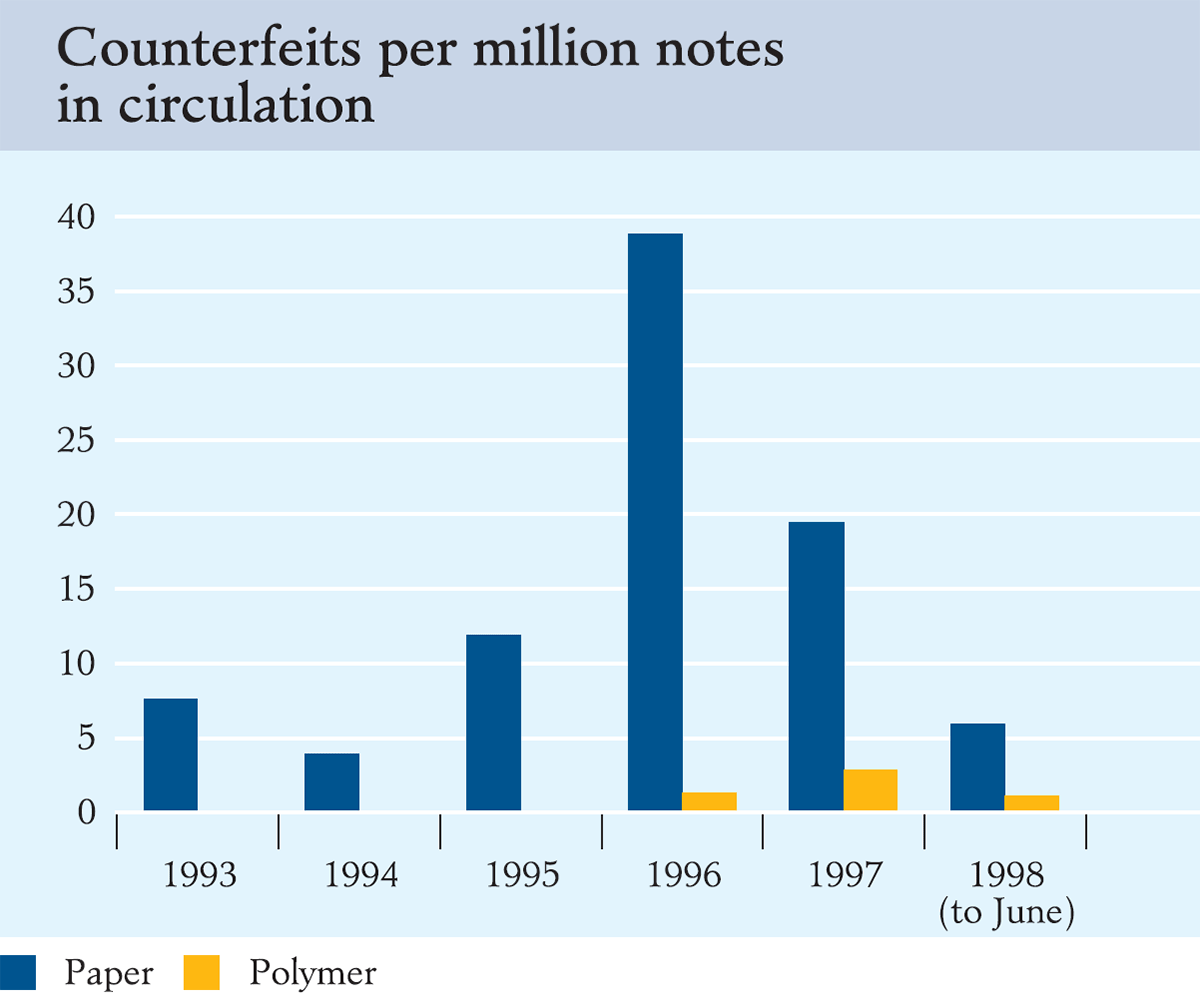
The big rise in counterfeiting in 1995 and 1996 was focused on the old paper notes series, mostly $50s and $100s. It reflected, among other things, easy access to colour copiers and scanning devices that required little technical skill to operate. Following the move to polymer for these denominations, counterfeits of the old paper series have fallen sharply.
Despite the Reserve Bank introducing the first polymer note of the new series in July 1992, counterfeits of the polymer note series did not surface until some four and a half years later, and then only in very small numbers. The first of these was a fairly crude version of the $50 polymer note. Initially, all counterfeits were produced on a paper substrate; in many instances, there was no clear window. Such counterfeits were easily detected, including by feel. More recently, a small number of $20 and $100 note counterfeits, which have been produced using a plastic substrate, have appeared. Despite having a reasonably good reproduction of the printed features, the counterfeits were again easily detected, as the thickness and feel were noticeably different from an authentic note; when crumpled, they made a distinctly different sound because of the different substrate being used; there was no embossing, or only a crude embossing, of the denomination in the clear window; and the transparent window lacked clarity.
The risk of counterfeiting is ever present and the Reserve Bank continues to conduct research and develop a new array of advanced features to improve even further the security of polymer notes.
New note design
In conjunction with the celebration of the Centenary of Federation in January 2001, the Reserve Bank plans to issue a new note. To assist in developing the design of the note, the Bank formed an advisory committee of a number of prominent community representatives. The group consisted of Neville Bonner (former Federal Senator), Tim Bowden (journalist), Philip Cox (architect), Brian Fletcher (historian), John Hirst (historian), Janet Holmes à Court (businesswoman), Hugh Mackay (social commentator), Irene Moss (NSW Ombudsman), Lois O'Donoghue (former chairperson of ATSIC) and Tim Potts (arts administrator).

The committee recommended that the Reserve Bank issue a new $5 note featuring Sir Henry Parkes on the front and Catherine Helen Spence on the back. This approach was accepted and design work for a new $5 note, to be issued early in 2001, has commenced. The note is being designed by Garry Emery, one of Australia's leading graphic designers (and designer of Australia's current $20 note). Mr Emery was selected in a competition with several other leading designers.
